1. What Is Ductile Cast Iron?
Ductile cast iron—often called nodular or spheroidal graphite iron—belongs to the family of cast irons but distinguishes itself by its spheroidal graphite inclusions.
Unlike gray iron, which contains flake‑like graphite that creates stress concentrators and brittleness, ductile iron’s nodular graphite resists crack initiation and promotes tear‑resistant fracture behavior.
Developed in the early 1940s and commercialized by the International Nickel Company in 1948,
Ductile iron revolutionized heavy‑duty components by combining castability, high tensile strength (up to 1000 MPa in specialty grades), and notable ductility (elongation as high as 20% in fully ferritic grades).
Its matrix can range from fully ferritic—offering maximum ductility—to fully pearlitic—maximizing strength—allowing engineers to tailor properties across a spectrum of 400–1000 MPa UTS and 10–20% elongation.
By understanding its unique nodular microstructure and adjustable matrix phases, designers harness ductile iron to meet rigorous safety, longevity, and cost targets.
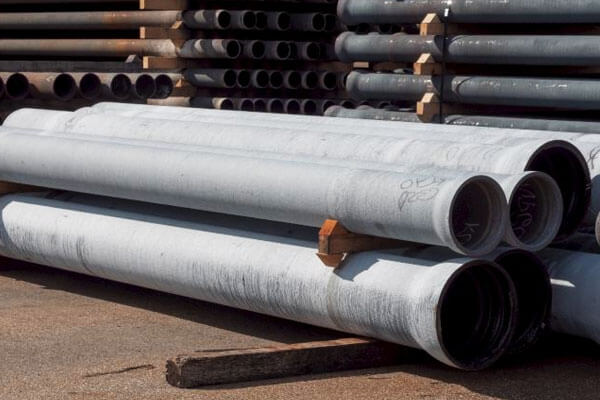
2. Microstructure and Chemistry
Ductile cast iron derives its exceptional combination of strength, ductility, and fatigue resistance from a carefully engineered microstructure.
Two features in particular—graphite morphology and matrix phase composition—define its mechanical behavior.
Graphite Morphology: Nodules vs. Flakes
Unlike gray iron’s flake graphite, which creates sharp crack‑initiating stress concentrators, ductile iron forms nearly spherical graphite nodules.
Typical nodule counts range from 100 to 300 nodules/mm², with nodularity above 80% ensuring optimal crack‑arresting performance.
Studies show that a nodule count above 200/mm² can increase tensile strength by up to 15% and double impact energy absorption compared to lower nodule densities.
Key takeaway: Spheroidal graphite interrupts crack paths, promoting ductile fracture and energy absorption rather than brittle cleavage.
Matrix Phases: Ferrite, Pearlite, and Mixed Structures
The iron matrix surrounding these nodules further tailors mechanical properties:
- Fully Ferritic Matrix
-
- Composition: ≥ 90% ferrite
- Properties: Elongation up to 20%, UTS around 350–450 MPa
- Applications: Components requiring high ductility, such as shock‑absorbing housings
- Pearlitic Matrix
-
- Composition: ≥ 90% pearlite
- Properties: UTS up to 650–800 MPa, elongation limited to 6–8%
- Applications: High‑strength gears and shafts
- Mixed Ferrite–Pearlite
-
- Composition: Balanced phases (e.g., 50:50)
- Properties: UTS 400–550 MPa with elongation 10–15%
- Applications: General‑purpose castings combining strength and toughness
Manufacturers adjust cooling rates—using mold chills or insulated sections—to shift the ferrite‑pearlite ratio and hit performance targets.
Alloying Elements and Inoculation
Precise alloy chemistry and inoculation practices underpin consistent nodule formation and matrix control:
- Carbon (3.2–3.6%) and Silicon (1.8–2.8%) set the baseline for castability and graphite stability.
- Magnesium (0.02–0.06%) acts as a powerful nodulizer; insufficient Mg leads to irregular graphite shapes.
- Cerium or Rare Earths (0.005–0.02%) further refine nodule geometry and reduce residual carbides.
Foundries introduce these elements via inoculants—ferrosilicon‑magnesium alloys added at 0.2–0.4% by weight just before pouring.
Proper inoculation lowers the likelihood of graphite degeneration, ensuring a uniformly nodular structure.
For example, increasing Mg from 0.03% to 0.05% can raise nodule count by 20%, boosting fatigue life by 30% in rotating components.
3. Standard Classifications & Grades
ASTM A536 Grade Designations
The ASTM A536 standard uses a three‑number system (e.g., 65–45–12) where each number represents a mechanical benchmark:
- 65 denotes a minimum ultimate tensile strength (UTS) of 650 MPa.
- 45 specifies a minimum yield strength (0.2% offset) of 450 MPa.
- 12 indicates a minimum elongation at fracture of 12 percent.
A536 defines three principal grades by tensile strength, yield strength, and elongation:
- 65–45–12: UTS ≥ 650 MPa, YS ≥ 450 MPa, Elongation ≥ 12%
- 80–55–06: UTS ≥ 800 MPa, YS ≥ 550 MPa, Elongation ≥ 6%
- 100–70–03: UTS ≥ 1000 MPa, YS ≥ 700 MPa, Elongation ≥ 3%
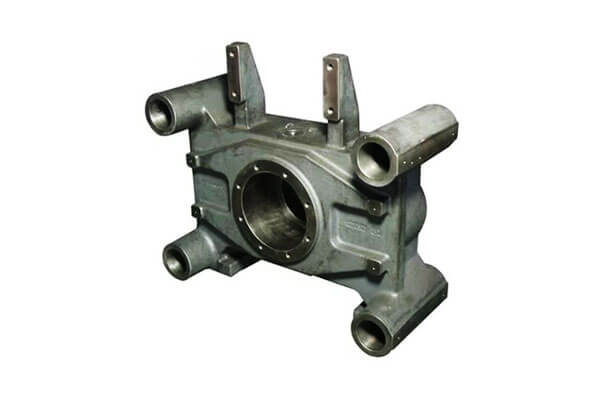
EN‑GJS Nomenclature
In Europe, EN 1563 defines nodular irons with labels such as GJS‑400‑15 or GJS‑600‑3:
- GJS stands for “grafite spheroidal,” indicating nodular graphite.
- The first number (e.g., 400) equals UTS in MPa (GJS‑400‑15 → 400 MPa).
- The second number (e.g., 15) gives elongation in percent.
This metric system aligns closely with ASTM grades: GJS‑400‑15 corresponds roughly to ASTM A536 65–45–12, while GJS‑600‑3 matches 100–70–03.
4. Fundamental Mechanical Properties
This section examines its key metrics—tensile and yield strength, ductility and impact toughness, and hardness—and explains how standardized tests verify each attribute.
Tensile and Yield Strength
Ductile iron’s tensile strength ranges broadly from 350 MPa in fully ferritic grades up to 1000 MPa in specialty, high‑strength alloys.
- General‑purpose grades such as ASTM A536 65–45–12 exhibit ultimate tensile strengths around 650 MPa and yield strengths near 450 MPa.
- High‑strength grades (80–55–06) push tensile strength to 800 MPa at a yield of 550 MPa, while austempered variants easily exceed 1000 MPa.
Standard tensile testing follows ASTM E8, which prescribes a constant crosshead speed and a dog‑bone specimen geometry.
Yield strength—determined at 0.2% offset—indicates the onset of permanent deformation, guiding designers in selecting safety factors and load limits.
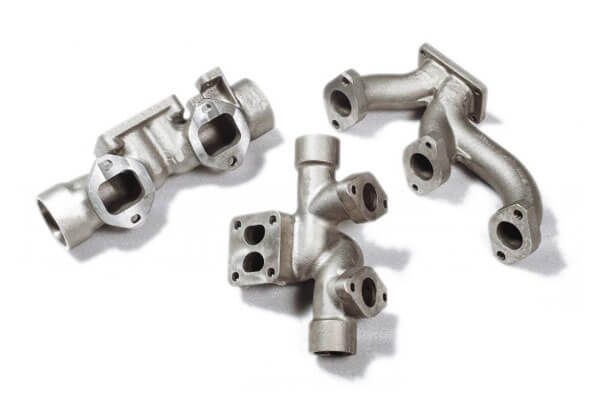
Ductility and Impact Toughness
Ductility, measured as elongation at fracture, varies from 6% in fully pearlitic irons to over 20% in fully ferritic grades.
For most mixed‑matrix castings (e.g., 50:50 ferrite–pearlite), engineers can expect 12–15% elongation, striking a practical balance between formability and strength.
Impact toughness, assessed via Charpy V‑notch tests (ASTM E23), typically falls between 30 J and 60 J at room temperature.
Moreover, ferritic grades often absorb over 70 J, making them ideal for components subject to shock loading and dynamic stresses.
These values underscore ductile iron’s ability to deform plastically under sudden loads, reducing catastrophic fracture risks.
Hardness and Wear Resistance
Hardness correlates closely with both tensile strength and wear resistance.
Ductile iron’s Brinell Hardness Number (BHN) usually spans 170–280 HB, with typical grades clustering around 190–230 HB.
In addition, Rockwell hardness tests (e.g., HR B scale) offer quick, on‑site verification of heat treatment and matrix condition.
As a rule of thumb, every 50 HB increase in Brinell hardness corresponds to a 150–200 MPa rise in tensile strength.
Consequently, surface‑hardened or austempered ductile irons—with BHN values exceeding 300—can endure abrasive environments and high‑cycle wear without sacrificing core toughness.
Summary of Key Properties
| Property | Typical Range | Test Standard |
|---|---|---|
| Ultimate Tensile Strength | 350–1000 MPa | ASTM E8 |
| Yield Strength (0.2% offset) | 250–700 MPa | ASTM E8 |
| Elongation at Fracture | 6–20% | ASTM E8 |
| Charpy Impact Energy | 30–70 J (room temp) | ASTM E23 |
| Brinell Hardness (BHN) | 170–280 | ASTM E10 |
5. Fatigue and Fracture Behavior
Ductile iron excels in fatigue because its spherical graphite nodules distribute stress and slow crack growth.
In rotating‑bending tests, 65–45–12 specimens survive 10⁶ cycles at stress amplitudes of 200 MPa, compared to 80 MPa in gray iron.
Crack initiation often occurs at surface inclusions, but nodular graphite delays propagation.
Compared to low‑alloy steel, ductile iron achieves equivalent high‑cycle fatigue life with 20–30% lower density, offering weight savings in cyclic applications.
6. Elevated‑Temperature and Creep Properties
When components face sustained loads at elevated temperatures, ductile cast iron proves remarkably resilient.
Engineers often deploy grades like 65–45–12 in exhaust manifolds, turbocharger housings, and other hot‑section parts because it maintains strength and resists time‑dependent deformation up to approximately 300 °C.
Thermal Stability of Mechanical Strength
Immediately upon heating, ductile iron undergoes some softening.
For a mixed ferrite–pearlite grade (e.g., 65–45–12), room‑temperature tensile strength near 650 MPa drops to about 550–580 MPa at 250 °C (≈ 85–90% retention).
At 300 °C, UTS still measures roughly 500 MPa, enabling designers to rely on predictable load‑bearing capacity in high‑temperature environments.
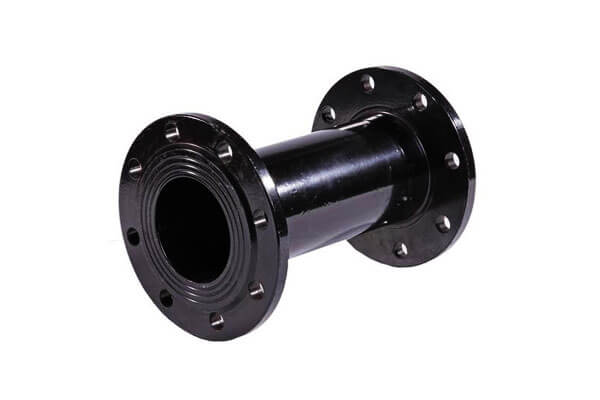
Creep Resistance and Lifetime Estimation
Creep—slow, irreversible deformation under constant load—becomes critical in hot‑section components.
The creep tests on 65–45–12 ductile iron show primary and secondary creep behavior at 250 °C under a stress of 200 MPa:
- Primary creep (strain rate decelerates) spans the first 100–200 h.
- Secondary (steady‑state) creep proceeds at a low strain rate of 10⁻⁷ s⁻¹, implying less than 1% additional elongation over 1 000 h.
Extrapolating via the Larson–Miller parameter, engineers predict 10 000 h to 1% creep strain at 200 MPa/300 °C, matching service requirements for many turbochargers and exhaust manifolds.
Creep Mechanisms in Ductile Iron
Creep in ductile iron involves dislocation glide within the ferritic matrix and sliding at ferrite–pearlite interfaces.
Graphite nodules act as obstacles, further slowing deformation. Compared to gray iron, ductile iron demonstrates 2–3× higher creep rupture lives under identical stress–temperature conditions.
Typical High‑Temperature Applications
- Exhaust Manifolds: With peak surface temperatures up to 600 °C, the backing structure sees 200–300 °C in service.
Ductile iron’s ability to endure cycling between ambient and 300 °C without cracking makes it ideal. - Turbocharger Housings: Constant exposure to 350–450 °C exhaust gas demands both thermal shock resistance and creep stability.
Grades such as 80–55–06 (800 MPa UTS) often serve here, thanks to their higher pearlite content and matrix stability.
Design Implications
Given this data, designers should:
- Specify Grades by Operating Temperature: Use ferritic grades for up to 250 °C, and mixed or pearlitic grades (e.g., 80–55–06) when temperatures hover closer to 300 °C.
- Account for Creep‐Allowances: Incorporate 1–2% additional section thickness in long‑term creep applications to compensate for expected strain over service life.
- Apply Safety Factors: Increase design stress margins by 20–30% above steady‑state creep stress to guard against unexpected thermal spikes.
7. Manufacturing & Heat‑Treatment Effects
While ductile cast iron’s microstructure and composition set the stage for its mechanical properties, the manufacturing process and post‑cast heat treatments determine the final performance.
By controlling pouring parameters, cooling rates, nodule count, and thermal processing, foundries tailor ductile iron to meet stringent application demands.
Pouring Practices and Cooling Rate
Foundries pour molten ductile iron at temperatures between 1420 °C and 1480 °C to ensure complete mold filling without excessive oxidation.
After pouring, the cooling rate, influenced by mold material, section thickness, and use of chills, dictates the ferrite‑pearlite balance.
For example, a 15 mm wall section cooled at 5 °C/s typically yields ~60% pearlite, boosting tensile strength to 550 MPa with 8% elongation.
In contrast, the same section cooled at 1 °C/s develops ~80% ferrite, achieving 400 MPa UTS and 15% elongation.
Engineers leverage these cooling‑rate effects to optimize castings: faster cooling for high‑strength gears, slower cooling for impact‑resistant housings.

Nodule Count and Inoculation Techniques
Graphite nodularity—measured as the percentage of nodular graphite vs. total graphite area—strongly depends on inoculation.
Foundry inoculation adds 0.2–0.4% ferrosilicon‑magnesium alloy to the ladle, producing 80–95% nodularity and 150–250 nodules/mm².
For critical wear surfaces, case inoculation (“surface inoculation”) augments the last pour stream, raising surface nodule density by 10–20% without altering core microstructure.
This dual approach ensures consistent mechanical properties throughout thick sections and maximizes wear resistance where it matters most.
Heat Treatment Methods
Heat treatment is a powerful tool for tailoring the mechanical properties of ductile cast iron for specific engineering applications. Commonly used techniques include:
- Annealing: Typically performed at 870–950 °C, followed by slow furnace cooling, annealing transforms pearlitic matrices into ferritic ones, greatly enhancing ductility and impact resistance.
It is often used for components that require high toughness and low brittleness. - Normalizing: Conducted at ~900 °C with air cooling, this process refines the grain structure and promotes a more uniform pearlitic or mixed matrix.
It enhances both strength and machinability, making it suitable for gears, hubs, and brackets. - Austempering: This advanced heat treatment transforms ductile iron into Austempered Ductile Iron (ADI) by quenching the casting into a salt bath (~250–400 °C) and holding until a bainitic matrix forms.
The resulting structure exhibits superior strength (up to 1,400 MPa) and wear resistance while maintaining reasonable ductility.
Process Control and Consistency
Maintaining tight process control—monitoring pour temperature within ±10 °C, tracking inoculant addition within ±0.02%, and verifying mold temperatures—ensures batch‑to‑batch repeatability.
In-situ thermocouples and automated inoculation systems alert operators to deviations, preventing microstructural anomalies such as nodularity drops below 75% or excessive carbide formation.
These quality‑control measures uphold mechanical property targets and minimize scrap rates.
8. Applications of Ductile Iron
Automotive Industry
- Crankshafts – due to their high fatigue resistance and toughness, ductile iron crankshafts can withstand millions of cycles under dynamic loads.
- Differential cases and gears – benefit from the alloy’s wear resistance and ability to absorb shocks.
- Steering knuckles, control arms, and suspension components – where a combination of ductility and high tensile strength ensures both safety and performance.
Pumps and Valves
- Pump housings and impellers
- Valve bodies for water, oil, and gas systems
- Pipe fittings and flanges in municipal and industrial applications
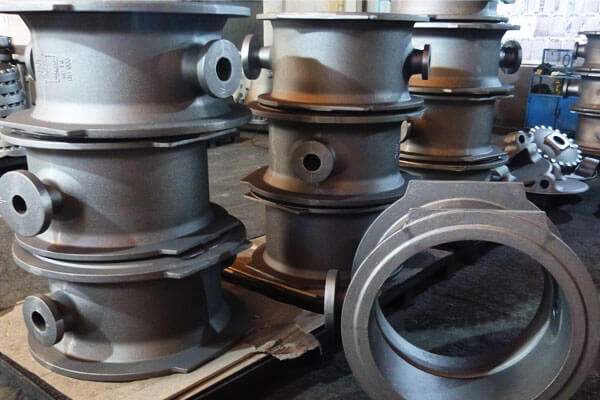
Wind and Renewable Energy
- Gearbox housings
- Rotor hubs
- Bearing carriers
Agricultural and Heavy Equipment
Components such as axle housings, brackets, and track rollers are cast from ductile iron for its ability to resist deformation under large loads and its ease of fabrication into complex shapes.
Oil, Gas, and Marine Industries
- Pipeline systems
- Offshore platform components
- Subsea manifolds
9. Comparative Analysis with Other Materials
Here’s a comprehensive comparison table that consolidates the performance characteristics of Ductile Cast Iron, Gray Cast Iron, Forged Steel, and Austempered Ductile Iron (ADI) into a professional table:
| Property | Gray Cast Iron | Ductile Cast Iron | Forged Steel (e.g., AISI 1045) | Austempered Ductile Iron (ADI) |
|---|---|---|---|---|
| Graphite Morphology | Flake | Spheroidal (nodular) | None | Spheroidal in ausferritic matrix |
| Tensile Strength (MPa) | 150–300 | 450–700 | 600–850 | 900–1,400 |
| Yield Strength (MPa) | ~100–200 | 300–500 | 350–600 | 600–1,200 |
| Elongation (%) | <1 | 5–20 | 12–20 | 2–10 |
| Fatigue Strength (MPa) | <150 | 200–300 | 300–400 | 300–450 |
| Hardness (HB) | 130–220 | 150–250 | 170–280 | 250–550 |
| Density (g/cm³) | ~7.1 | ~7.0 | ~7.85 | ~7.0 |
| Impact Resistance | Poor | Moderate to High | High | High |
| Machinability | Excellent | Excellent | Moderate to Good | Moderate |
| Wear Resistance | Low | Moderate | Moderate | Excellent |
| Thermal Conductivity | High | Moderate | Low | Moderate |
| Cost | Low | Moderate | High | Higher (due to heat treatment) |
| Applications | Engine blocks, housings | Crankshafts, gears, pumps | Shafts, structural parts | Gears, sprockets, wear-resistant parts |
10. Conclusion
Ductile cast iron stands at the crossroads of cost‑effective casting and high mechanical performance.
Its nodular graphite structure imparts strength, toughness, and fatigue resistance, while alloying and processing allow fine‑tuning for specific applications.
By adhering to standard classifications, controlling microstructure, and implementing rigorous quality protocols, engineers harness ductile iron to produce safe, durable, and economical components.
As innovations like ADI and additive manufacturing emerge, ductile cast iron will continue evolving, reinforcing its role as a cornerstone material in modern engineering.
LangHe is the perfect choice for your manufacturing needs if you need high-quality ductile cast iron products.


